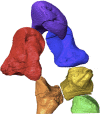Laterality and grip strength influence hand bone micro-architecture in modern humans, an HRpQCT study
- PMID: 28421607
- PMCID: PMC5442142
- DOI: 10.1111/joa.12608
Laterality and grip strength influence hand bone micro-architecture in modern humans, an HRpQCT study
Abstract
It is widely hypothesized that mechanical loading, specifically repetitive low-intensity tasks, influences the inner structure of cancellous bone. As such, there is likely a relationship between handedness and bone morphology. The aim of this study is to determine patterns in trabecular bone between dominant and non-dominant hands in modern humans. Seventeen healthy patients between 22 and 32 years old were included in the study. Radial carpal bones (lunate, capitate, scaphoid, trapezium, trapezoid, 1st, 2nd and 3rd metacarpals) were analyzed with high-resolution micro-computed tomography. Additionally, crush and pinch grip were recorded. Factorial analysis indicated that bone volume ratio, trabeculae number (Tb.N), bone surface to volume ratio (BS.BV), body weight, stature and crush grip were all positively correlated with principal components 1 and 2 explaining 78.7% of the variance. Volumetric and trabecular endostructural parameters (BV/TV, BS/BV or Tb.Th, Tb.N) explain the observed inter-individual variability better than anthropometric or clinical parameters. Factors analysis regressions showed correlations between these parameters and the dominant side for crush strength for the lunate (r2 = 0.640, P < 0.0001), trapezium (r2 = 0.836, P < 0.0001) and third metacarpal (r2 = 0.763). However, despite a significant lateralization in grip strength for all patients, the endostructural variability between dominant and non-dominant sides was limited in perspective to inter-individual differences. In conclusion, handedness is unlikely to generate trabecular patterns of asymmetry. It appears, however, that crush strength can be considered for endostructural analysis in the modern human wrist.
Keywords: grip strength; human; laterality; trabecular bone; wrist.
© 2017 Anatomical Society.
Figures




Similar articles
-
Trabecular architecture in the thumb of Pan and Homo: implications for investigating hand use, loading, and hand preference in the fossil record.Am J Phys Anthropol. 2016 Dec;161(4):603-619. doi: 10.1002/ajpa.23061. Epub 2016 Aug 8. Am J Phys Anthropol. 2016. PMID: 27500902
-
The reliability of cone-beam computed tomography to assess bone density at dental implant recipient sites: a histomorphometric analysis by micro-CT.Clin Oral Implants Res. 2013 Aug;24(8):871-9. doi: 10.1111/j.1600-0501.2011.02390.x. Epub 2012 Jan 17. Clin Oral Implants Res. 2013. PMID: 22250839
-
Of mice, rats and men: trabecular bone architecture in mammals scales to body mass with negative allometry.J Struct Biol. 2013 Aug;183(2):123-31. doi: 10.1016/j.jsb.2013.04.009. Epub 2013 Apr 30. J Struct Biol. 2013. PMID: 23639903
-
A literature review of the effect of handedness on isometric grip strength differences of the left and right hands.Am J Occup Ther. 2001 Mar-Apr;55(2):206-11. doi: 10.5014/ajot.55.2.206. Am J Occup Ther. 2001. PMID: 11761137 Review.
-
Micro-tomographic imaging for the nondestructive evaluation of trabecular bone architecture.Stud Health Technol Inform. 1997;40:61-79. Stud Health Technol Inform. 1997. PMID: 10168883 Review.
Cited by
-
How does bone microanatomy and musculature covary? An investigation in the forelimb of two species of martens (Martes foina, Martes martes).J Anat. 2022 Jul;241(1):145-167. doi: 10.1111/joa.13645. Epub 2022 Mar 9. J Anat. 2022. PMID: 35266144 Free PMC article.
-
Sesamoid bones also show functional adaptation in their microanatomy-The example of the patella in Perissodactyla.J Anat. 2022 Jan;240(1):50-65. doi: 10.1111/joa.13530. Epub 2021 Aug 16. J Anat. 2022. PMID: 34402049 Free PMC article.
-
Early Holocene morphological variation in hunter-gatherer hands and feet.PeerJ. 2018 Sep 5;6:e5564. doi: 10.7717/peerj.5564. eCollection 2018. PeerJ. 2018. PMID: 30202658 Free PMC article.
References
-
- Crockett K, Arnold CM, Farthing JP, et al. (2015) Bone strength and muscle properties in postmenopausal women with and without a recent distal radius fracture. Osteoporos Int 26, 2461–2469. - PubMed
-
- Erlandson MC, Kontulainen SA, Chilibeck PD, et al. (2012) Higher premenarcheal bone mass in elite gymnasts is maintained into young adulthood after long‐term retirement from sport: a 14‐year follow‐up. J Bone Miner Res 27, 104–110. - PubMed
-
- Frost HM (1987) Bone “mass” and the “mechanostat”: a proposal. Anat Rec 219, 1–9. - PubMed
MeSH terms
LinkOut - more resources
Full Text Sources
Other Literature Sources
Research Materials

